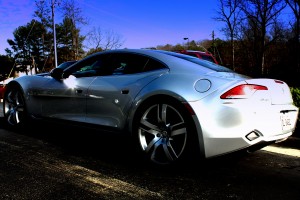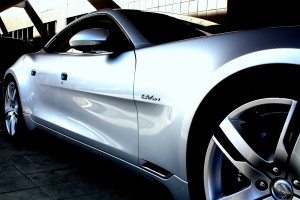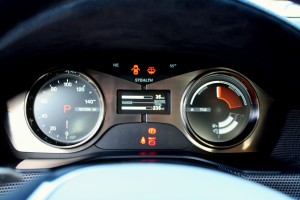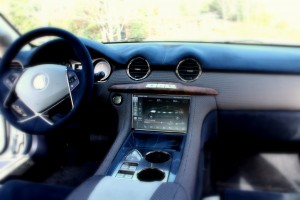After years of waiting for Henrik Fisker’s radical and ambitious concept to become a real production vehicle, I laid eyes on a production Karma recently at Caffeine & Octane, a local monthly gathering of enthusiasts and their cars. Days later, I was behind the wheel of said car, getting my first real impression of this unparalleled machine.
Intellectual justification for buying a Karma may be difficult, but the car’s deep emotional appeal is hard to resist. It’s a car for the heart, not for the brain.
The Karma has Fisker’s EVer drivetrain, a plug-in capable series hybrid setup, but its green cred is offset by a 5200-lb. curb weight and big, staggered-width tires. It has a luxurious interior, but the $100,000 base model lacks navigation, and no Karma has high-tech features like adaptive cruise or self parking. Its wood trim is “rescued” from storm-struck forests or pulled from the depths of Lake Michigan, but just a single narrow strip adorns the dash. The Karma is certainly exclusive now, but any success it finds in the marketplace will make it less rare.
But the renowned auto designer and company co-founder Henrik Fisker penned a machine that pulls you in with it’s gorgeous lines and proportions. Plus, it’s electric propulsion takes luxury automobiles in a new direction.
Although priced similarly to more conventional vehicles from companies like Mercedes-Benz and Porsche, these may not be this Fisker’s biggest competition. Only exotics can offer the exclusivity of the Karma, at least in these early days, so customers might compare it to more expensive cars from makers like Bentley or Aston Martin. The Karma may fare much better in this upper echelon since rational considerations like convenience features may be less important than the use of rare wood for dash detailing.
The Karma is certainly quick. If you’re willing to burn quickly through the Karma’s 30- to 50-mile electric-only range, “Stealth” mode acceleration blasts are quiet and swift. In “Sport” mode, the engine-generator’s constant rpm has the sound of a car equipped with a CVT. The four-cylinder can be relatively loud for a luxury car under full acceleration. I did not drive the Karma on the highway, but I’m curious about engine noise at 70 or 80 mph.
Does it feel like 400 horsepower? It’s hard to say with the Karma’s unique aural sensations of speed. Single-speed gearing means relatively flat acceleration – it’s just one long, smooth run up to speed. Both with the engine-generator on and with it off, the sound is not ordinary. And the car is powerful, but it’s heavy, too. The 400-hors V8-powered BMW X5 would be a good drag racing challenger and could help determine if the Karma is as quick as a conventional gasoline vehicle with similar weight and power. According to Fisker’s and BMW’s numbers, the SUV should beat the hybrid by about half a second with the Karma in sport mode, but an independent test remains unseen.
According to Fisker’s and BMW’s numbers, the SUV should beat the hybrid by about half a second with the Karma in sport mode, but an independent test remains unseen.
The Karma’s “Hill” functions allow two levels of regenerative braking as soon as the driver’s foot is lifted off of the accelerator. I tried this single-pedal mode to great satisfaction on a steep descent. The vehicle kept a controlled speed with no foot on either pedal while the power gauge displayed my energy gain.
The Karma shuttered a bit right at takeoff. I’ve experienced that in electric-driven vehicles like golf carts, but not in other electric vehicles I’ve driven. In a premium luxury car like the Karma, it was annoying.
So the Karma is wonderful, even if it’s not yet everything it could be. If you’ve got two-hundred grand to spend, the Karma is a bargain that will satisfy your desire for a relatively fast, luxurious and exclusive head-turner with an environmentally responsible attitude. If the Karma is at or near the top of your budget, vehicles like the Panamera Hybrid or S400 Hybrid offer a green edge, excellent equipment, and proven build quality and dealer infrastructure.

